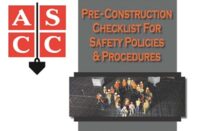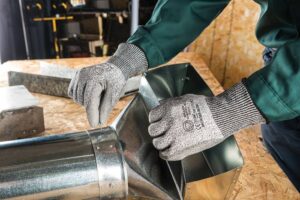A we approach the 2016 Concrete Decor show, the reality is hitting me that I will no longer be a casual observer to the amazing creations at the workshops or learning in the classroom but instead will be playing an active role as a resource for anyone who has questions regarding construction safety.
The question I’d ask as a participant or reader would be, “why safety?” As in, why should I be concerned about safety when my focus is on learning new skills or gaining business advice that I can use to improve my business? It’s a fair question and, aside from the moral aspect of having a safe place to work so everyone goes home at the end of the day, there’s a strong argument that investing in safer work practices will transfer to improved business or financial gains.
More and more companies are shifting from treating safety as a standalone item that gets pushed aside when the schedule or budget gets tight. Instead, they are incorporating safety into the planning process and managing it along with quality control, scheduling, budgeting, communication, productivity and client satisfaction.
In this way, “safety” shifts from being something we must do to comply with regulations to an investment that seeks to improve worker retention, marketability, and internal and external communication, while reducing long-term costs.
Money talks
I know of several companies that formed safety committees and along the way discovered communication, coordination and employee suggestions provided benefits far beyond their original intent of safety. In many ways, the groups turned into continuous process improvement committees that resulted in increased quality and productivity.
One of the first things I hear when companies are making progress toward reducing injuries or improving their safety culture is how their Experience Modification Rate (EMR) went down and they are now paying less in workers’ compensation insurance. This reduction in money paid out for insurance premiums directly translates into a competitive advantage during the bidding process.
Help wanted
Everywhere I go, I hear contractors from all trades tell me they’re struggling to find good workers and in some cases to find any workers at all. As one guy put it, “If you know of anyone with a heartbeat, my boss will probably hire him right now.”
For the first time, I’ve heard of companies going to high schools to actively recruit students to consider jobs in construction. This makes for an opportunity to promote a positive safety culture as a way to help you stand out as an employer seeking to hire qualified new employees.
It seems as though the industry is drawing from a relatively small group of young adults who are willing to brave the elements to earn an honest living by the sweat of their brows. This group is made even smaller if there is also a risk of death, injury or developing long-term health problems.
In addition to encouraging employees new to construction is the challenge of either keeping existing hard-working employees or recruiting seasoned workers to join your team. Providing a safe work environment is a win-win for all.
Customer focused
Incorporating safety into your company’s culture also has an indirect impact on your business. A perceived professionalism accompanies a clean orderly worksite, well-trained employees and improved communication brought about by early planning. These are part of an implied quality that customers can expect from the finished product.
Implied quality is also transferred to potential customers through direct observation or word of mouth. Just as a filthy restaurant should make you question food quality, a disorganized site full of visible safety hazards makes customers question the quality of work being performed or the liability they must assume with you on their property.
So now what?
If you’re just starting out or working job to job, it may be difficult to justify spending time on safety. However, that makes it all the more important to not incur any lost income or production due to a preventable incident or injury to you or one of your co-workers.
If you’re part of a large company that’s comfortable with safety, don’t let comfort turn into complacency. Also, don’t delegate safety to just one person; integrate it throughout the entire workforce.
In addition to providing a safe workplace and peace of mind in knowing you’re doing what’s right, there are other benefits to investing in safety. We covered monetary benefits due to lower workers’ comp insurance, advantages of employee recruiting and retainage, and the marketability of safety as part of a well-rounded professional portfolio. These are just scratching the surface and don’t get into the savings of direct and indirect costs by preventing a serious injury.
For the employee who may be reading this, the reason to work safely would be the very reason that gets you out of bed each morning. For many I know, that means providing for their family, the promise of a better future and the satisfaction of a job well done. It’s difficult to do any of these if you get injured and impossible if you are dead.
This topic of “why” is part of a lead-in to the much larger topic of “how.” How do we initiate safety improvements for a company starting from scratch or how do we improve a safety culture in a company with a solid safety foundation?
This can be as specific as singling out certain common tasks, such as the proper use of ladders, scaffolds and fall protection, or as broad as how to effectively implement the various elements of a safety and health management system. I look forward to reader feedback to help guide this discussion.















